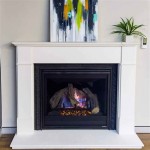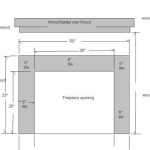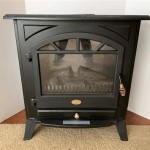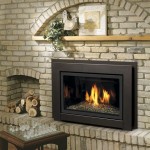```html
Custom Fireplace Mantel Shelf: A Guide to Design, Materials, and Installation
A fireplace mantel shelf serves as a focal point within a living space, providing both visual appeal and functional utility. Beyond mere aesthetics, a well-chosen and correctly installed mantel shelf can enhance the overall design and ambiance of a room. Custom-built mantel shelves offer a unique opportunity to tailor the design to specific architectural styles, personal preferences, and practical needs. This article explores various aspects of custom fireplace mantel shelves, covering design considerations, materials, and installation processes.
Design Considerations for Custom Mantel Shelves
The design of a custom fireplace mantel shelf necessitates careful consideration of several factors. These include the existing architectural style of the house, the type of fireplace (gas, wood-burning, electric), the size and proportions of the fireplace surround, and the intended use of the mantel shelf. The design process should start with an assessment of the overall room decor to ensure cohesiveness.
Architectural Style: The mantel shelf should complement the existing architectural style. In a traditional setting, a mantel shelf crafted from solid wood with ornate carvings might be appropriate. Conversely, a modern setting might benefit from a minimalist design using clean lines and materials like concrete or metal. Choosing a design that clashes with the architectural style of the room can create an incongruous and visually jarring effect.
Fireplace Type: The type of fireplace significantly impacts design choices. Wood-burning fireplaces generate considerable heat, requiring the mantel shelf to be positioned at a safe distance above the firebox opening, as mandated by building codes. Non-combustible materials or heat shields may be necessary to protect the mantel shelf from excessive heat exposure. Gas and electric fireplaces generally produce less heat, allowing for greater flexibility in design and material selection. Nevertheless, manufacturers' guidelines concerning clearances must be strictly followed to prevent safety hazards and ensure proper ventilation.
Size and Proportions: The dimensions of the mantel shelf are crucial for achieving visual balance. The length of the mantel shelf should ideally extend slightly beyond the width of the fireplace surround, typically by a few inches on each side. The depth of the mantel shelf should be sufficient to accommodate decorative items without appearing overly bulky. The height of the mantel shelf above the firebox opening is dictated by safety regulations and aesthetic considerations. A mantel shelf that is too small or too large relative to the fireplace and surrounding wall can disrupt the overall visual harmony of the room.
Intended Use: Consider the intended use of the mantel shelf. If it will be primarily used for displaying decorative items, the depth and weight-bearing capacity are important factors. If the mantel shelf will serve as a storage space or a surface for placing electronic devices, the design should incorporate features such as concealed wiring and adequate support. Anticipating the intended use of the mantel shelf during the design phase will ensure its functionality and prevent future problems.
Software tools can greatly assist in visualizing and refining the design. Computer-aided design (CAD) programs and three-dimensional modeling software allow for the creation of detailed renderings of the mantel shelf, enabling precise adjustments to dimensions, materials, and finishes. These tools can also be used to simulate the appearance of the mantel shelf within the context of the existing room, providing a realistic preview of the final result.
Material Selection for Custom Fireplace Mantel Shelves
The choice of materials for a custom fireplace mantel shelf significantly influences its aesthetic appeal, durability, and fire resistance. Common materials include various types of wood, stone, concrete, and metal, each offering distinct advantages and disadvantages.
Wood: Wood is a popular choice for mantel shelves due to its natural beauty, versatility, and ease of workability. Hardwoods such as oak, maple, and cherry offer superior durability and resistance to wear and tear, while softwoods like pine and fir are more economical and easier to stain or paint. The type of wood selected should complement the overall design style and the color palette of the room. The wood should be properly seasoned and kiln-dried to minimize warping and cracking. Applying a fire-retardant coating can enhance the fire resistance of the wood.
Stone: Stone mantel shelves, such as those made from granite, marble, or limestone, offer a timeless and elegant appearance. Stone is highly durable, fire-resistant, and requires minimal maintenance. However, stone is more expensive and heavier than wood, requiring specialized installation techniques. The natural variations in color and veining of stone add to its unique character. Stone mantel shelves are particularly well-suited for traditional and formal settings.
Concrete: Concrete mantel shelves offer a modern and industrial aesthetic. Concrete is highly durable, fire-resistant, and can be cast into various shapes and sizes. Concrete can be stained or sealed to achieve different textures and colors. Concrete mantel shelves tend to be heavy and require strong structural support. Concrete is a suitable choice for contemporary and minimalist designs.
Metal: Metal mantel shelves, such as those made from steel, aluminum, or copper, offer a sleek and contemporary look. Metal is highly durable, fire-resistant, and can be powder-coated or painted to achieve different finishes. Metal mantel shelves are often used in conjunction with other materials, such as wood or stone, to create a mixed-media effect. Metal is a viable option for modern and industrial-inspired spaces.
When selecting materials, consider factors such as budget, aesthetic preferences, fire safety requirements, and structural limitations. Obtaining samples of different materials and finishes is recommended to visualize the final appearance of the mantel shelf. Consulting with a qualified contractor or designer can provide valuable insights into material selection and installation considerations.
Installation of Custom Fireplace Mantel Shelves
The installation of a custom fireplace mantel shelf requires precision and adherence to safety regulations. Proper installation ensures the structural integrity of the mantel shelf and prevents potential hazards. The installation process typically involves preparing the wall, attaching the mounting hardware, and securing the mantel shelf in place.
Wall Preparation: Before installing the mantel shelf, the wall must be properly prepared. Ensure that the wall is structurally sound and free of any cracks or imperfections. Locate wall studs using a stud finder and mark their positions. The mantel shelf should be securely attached to the wall studs to provide adequate support. If the wall is made of brick or concrete, use appropriate anchors and fasteners designed for masonry. Level the wall surface using shims if necessary to ensure that the mantel shelf sits flush against the wall.
Mounting Hardware: Select appropriate mounting hardware based on the weight and dimensions of the mantel shelf and the type of wall material. Common mounting hardware includes lag bolts, screws, and brackets. For heavy mantel shelves, consider using heavy-duty steel brackets that are specifically designed for supporting significant weight. Ensure that the mounting hardware is compatible with the wall anchors being used. Follow the manufacturer's instructions for installing the mounting hardware.
Securing the Mantel Shelf: Carefully position the mantel shelf against the wall, aligning it with the marked stud locations. Use a level to ensure that the mantel shelf is perfectly horizontal. Secure the mantel shelf to the wall studs using the appropriate fasteners. Pre-drilling pilot holes can prevent the wood from splitting. Tighten the fasteners securely, but avoid over-tightening, which could damage the wall or the mantel shelf. Conceal the fasteners with wood filler or decorative caps to create a clean and finished appearance.
Safety Considerations: Observe all safety regulations and building codes during the installation process. Wear appropriate safety gear, such as safety glasses and gloves. If working with power tools, follow the manufacturer's instructions and exercise caution. Ensure that the mantel shelf is installed at a safe distance above the firebox opening, as specified by building codes. If in doubt, consult with a qualified contractor or building inspector to ensure compliance with all safety regulations.
Post-installation, inspect the mantel shelf to ensure that it is securely attached to the wall and that there are no signs of instability. Apply a sealant or finish to protect the mantel shelf from moisture and wear. Regularly inspect the mantel shelf for any signs of damage or deterioration and address any issues promptly to prevent further problems.
```
Collection Of Premium Wood Fireplace Mantels Dogberry

Rustic Wood Fireplace Mantel Shelf Distressed Farmhouse Handmade Floating Beam Custom Grain Free

Custom Fireplace Mantel With Corbels Floating Rustic Tv Shelf Made Solid Wood

Large Wood Beam Mantle Shelf 78 84 Floating Fireplace Mantel

Vail Wood Mantel Shelf Fireplace Shelves Floating Mantelsdirect Com Remodel Prefab

Custom Fireplace Mantels Stoll Industries 50 Years Experience

Handmade Rustic Fireplace Mantel Shelf Cut Oak Tree Like Face By Antique Woodworks Custommade Com

Evermark Expressions 5 Ft Traditional Poplar Stain Grade Wood Shelf Mantel Tradp 60mtl The Home Depot

Unfinished Wood Floating Mantel Shelf Rustica

Steel Fireplace Mantel Shelf You Can Customize To Preference
Related Posts








